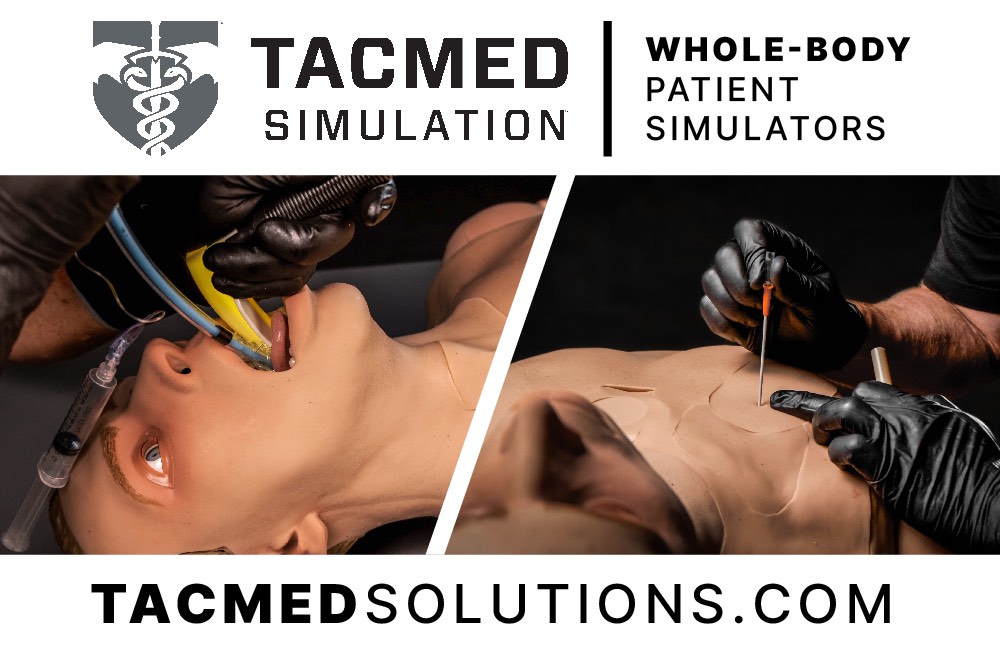Elevate Your Simulated EMS Training with Tactical Medical Solutions
The use of EMS simulation training continues to increase and expand around the globe. Nationally Registered Emergency Medical Technicians and Paramedic Trainers create the lifeblood of today’s Emergency Medical Services. According to the National Emergency Medical Services Information System, trauma makes up 21.4% of EMS calls with respiratory distress, chest pain, and cardiac arrest at 12.2%, 10.1%, and 1.8% respectively. Despite trauma’s high prevalence, simulators that support high-quality trauma training are often not the same as the simulators used in teaching facilities. Many EMS instructors are forced to teach trauma management with expensive, complicated, ACLS-focused “high fidelity” healthcare simulation manikins whose fake appearance and fragility prevent realistic training in real-world environments. Alternatively, some use inexpensive, durable but highly unrealistic “dummies” that poorly replicate medical procedures and give no feedback about performance. This HealthySimulation.com article discusses how Tactical Medical Solutions (TacMed) Simulation Technologies provide a means to elevate the National Registry of Emergency Medical Technicians (NREMT) training.
Tactical Medical Solutions recently hosted a “Maximizing Trauma Training through Simulation” workshop at IMSH 2023 where participants discussed the concept of “Right Fidelity” in trauma simulation. Right fidelity refers to simulator features that are critical to achieving learning aims while minimizing training scars. Hamstra et al., in “Reconsidering fidelity in simulation-based training,” write, “In simulation-based health professions education, the concept of simulator fidelity is usually understood as the degree to which a simulator looks, feels, and acts like a human patient.
Although this can be a useful guide in designing simulators, this definition emphasizes technological advances and physical resemblance over principles of educational effectiveness.” When assessing a simulator for the right fidelity, the instructor looks for features that improve or diminish educational effectiveness. Schoenherr and Hamstra, in “Beyond Fidelity: Deconstructing the Seductive Simplicity of Fidelity in Simulator-Based Education in the Health Care Professions,” elaborate on this concept by introducing the concept of affordances.
Sponsored Content:
They describe affordances as a simulator’s functional features considering the specific learning context. They propose that, in complex or simple simulators alike, it is the simulator’s affordances that are most important in imparting knowledge during simulation. In other words, the key to effective simulation is not low fidelity or high fidelity, but the right fidelity for what must be taught and learned. This is particularly true in trauma simulation.
Trauma simulation should impart or reinforce the knowledge that improves patient outcomes and the simulator should make this easier. Tourniquet training simulators can serve as a good example to explore this deeper. Teaching tourniquet placement to stop heavy bleeding is a common trauma simulation task. To be successful, the learner must recognize serious bleeding, have the manual knowledge to apply the tourniquet, and have a visceral understanding of the link between bleeding control and patient survival.
A right fidelity simulator would reinforce these skills. The simulator might have realistic appearing arterial blood flow and volume to reinforce recognizing serious bleeding. Its limbs might be calibrated for bleeding to stop at the proper tourniquet pressure to cement the haptic experience. Finally, the simulator might objectively measure blood loss tied to the simulator pulse, respirations, physiology, and “survival” to add the sense of urgency necessary when caring for bleeding trauma patients.
With the right fidelity paradigm in place, it is easy to see how some simulators EMS educators use just miss the mark, and not without consequence. Failing to tighten the tourniquet enough to stop bleeding is a common tourniquet placement error. If you learned tourniquet application on a wooden leg, or on a person’s arm, it is easy to see how a fall sense of confidence can develop.
Sponsored Content:
Recent TACMED HealthySimulation.com Webinar: Stop The Bleed: Realistic Trauma Intervention Training Tools
In this webinar, TacMed’s military and police expert Dan Stout will highlight some of the key “Stop the Bleed” components used during initial interventions in a trauma-related medical response, including the SOF-Tourniquet, Olaes, Trauma Bandage, hemostatic agents, and chest seals. These interventions will be demonstrated on a TacMed high-fidelity, a realistic simulator that can repeatedly replicate real-world injuries to EMS, Police, Military, and other Emergency First Responders.
In those simulators, you might carry out the task, but key indicators of successful performance or affordances like bleeding feedback could lead to poor learning. On the contrary, a well-designed simulator can create a lasting memory while giving the student and teacher objective feedback on task performance that can be tracked and analyzed over time. That is the value of right fidelity.
Trauma is common and trauma simulation is time well spent. From layperson “Stop the Bleed” training through complex multi-trauma, multi-patient EMS response, investing in the right fidelity simulation tools help instructors achieve learning objectives, particularly when training time is limited. TACMED Simulation patient simulators are designed with the right fidelity in mind.
Whether training firefighters or law enforcement officers with the lower complexity Whole Body EMITT – Tactical Medical/Active Shooter simulator or paramedics in the field or the ER with the more complex Whole Body Clinical Response – Resuscitate (WBS-CRU-R), each simulator reflects critical fidelity, where it matters, to achieve learning aims in any operational environment. Right fidelity can help you elevate your response and that changes patient outcomes.
More About TACMED
Tactical Medical Solutions, formerly known as Trauma F/X, develops and manufactures customized emergency response technology, advanced healthcare simulation and training aids, and personal protective gear to effectively manage a spectrum of hostile environments and injuries. The TacMed team’s passion is to serve and protect the health of communities, both at home and abroad. From point of injury throughout the continuum of clinical care; warfighters, first responders, and citizens alike, all rely on extensive tactical field experience and product knowledge to supply intuitive solutions. TacMed’s commitment to this life-saving mission is only matched by the integrity of the company’s team, the durability of products, and renowned customer support services.
The company’s products reflect on experiences and situations TacMed professionals have faced and friends that have been lost. The goal is to prevent others from experiencing similar losses by offering equipment that allows them to operate more efficiently and effectively. The company believes that minimizing preventable death in a combat or tactical environment is a realistic and attainable goal.
All TacMed employees are former tactical medical professionals or have a close relationship with them. Staff maintains close ties with some of the most elite and experienced medics in the world, and all TacMed products must pass their evaluation before the company name is placed on them. TacMed understands the principles of human performance as they relate to combat stress and seeks to design products to complement that performance not complicate them. This approach to product development and evaluation leads to products that truly work in combat.
Learn More About TACMED Simulation Technologies
References:
- Jordan, Richard Schoenherr and Stanley J Hamstra “Beyond Fidelity: Deconstructing the Seductive Simplicity of Fidelity in Simulator-Based Education in the Health Care Professions.” Simulation in Healthcare: The Journal of the Society for Simulation in Healthcare 12(2):p 117-123, April 2017.
- Hamstra, Stanley J. PhD; Brydges, Ryan PhD; Hatala, Rose MD, MSc; Zendejas, Benjamin MD, MSc; Cook, David A. MD, MHP. “Reconsidering Fidelity in Simulation-Based Training.” Academic Medicine 89(3):p 387-392, March 2014
- NEMSIS V2 911 CALL COMPLAINT VS. EMS PROVIDER FINDINGS DASHBOARD
https://nemsis.org/view-reports/public-reports/version-2-public-dashboards/v2-911-call-complaint-vs-ems-provider-findings-dashboard/
Dr. Dan Irizarry, MD, is Tactical Medical Solutions Senior Medical Advisor. Retiring in 2018, “Dr. Dan” served 26 years in the US Army supporting medical and special operation force (SOF) organizations. Serving as the NATO SOF medical advisor, he designed and launched NATO’s first combat medical simulation center to train SOF medical personnel. In his final military assignment, he helped launch the DoD’s medical simulation acquisition and advanced development office in Orlando, FL.
Today, he helps guide TacMed’s research and development efforts to ensure medical and simulation products meet the highest clinical standards. He continues to practice family medicine as the medical director for Kanan Medical, Inc., overseeing the healthcare delivery to over 30K patients through 5 clinics in Central Florida.
Sponsored Content:


















